Cleaning a Jacuzzi Bath Tub: Techniques and Best Practices
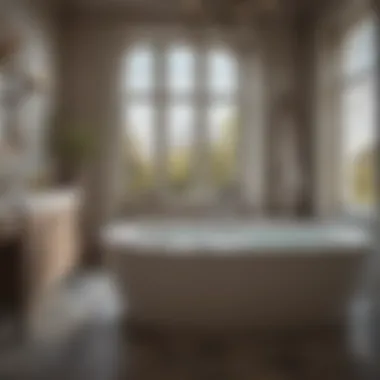
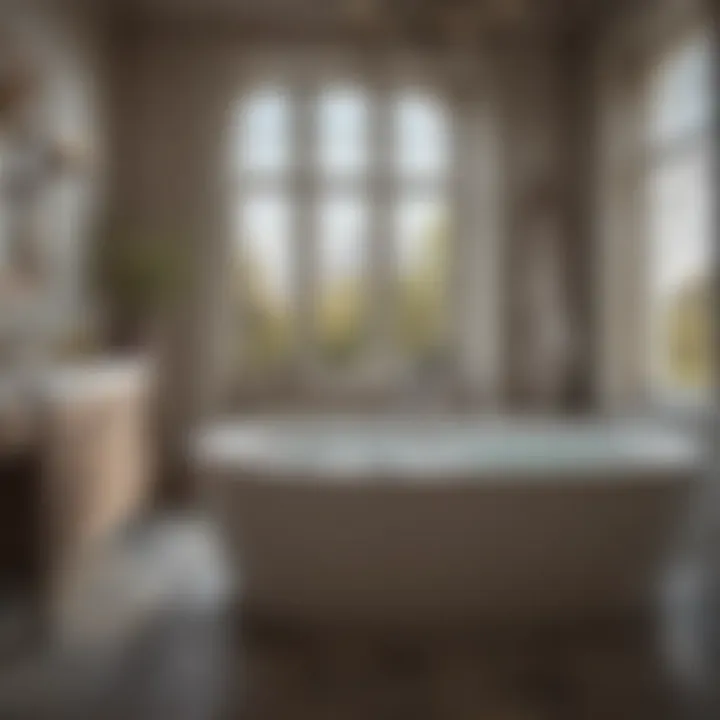
Intro
Cleaning a jacuzzi bath tub requires attention and care. These luxurious features can enhance any bathing experience, but maintaining their cleanliness is crucial for both aesthetic appeal and hygiene. Proper cleaning helps to prevent buildup of grime, soap scum, and other residues that can compromise functionality and comfort. In this guide, we aim to address the unique requirements for cleaning jacuzzi tubs, providing step-by-step methods, as well as common practices to ensure their longevity.
Design Inspirations
Latest Trends in Bath and Bedroom Design
A jacuzzi bath tub can serve as a centerpiece in a modern bathroom. Current trends emphasize minimalist and elegant styles. This can include incorporating natural materials and neutral color schemes. The surrounding decor should complement the tub. Keep in mind the role of lighting. Ambient lighting can soften the atmosphere and make the space more inviting.
Color Palettes and Themes
Choosing the right colors can enhance the ambiance. Earthy tones, such as muted greens and browns, work well with natural elements. Alternatively, cool shades like blues and greys can evoke a sense of tranquility. It is essential to coordinate colors with overall bathroom design. This helps create a cohesive look while promoting a sense of relaxation when it is time to unwind in the jacuzzi.
Functional Elements
Space Optimization Tips
Maximizing space around a jacuzzi bath tub can lead to a more enjoyable experience. Utilizing wall-mounted storage solutions can keep essentials within reach while maintaining an open area. Consider small accent tables for placing towels or other items. Decluttering surrounding areas simplifies the cleaning process, allowing thorough access to the tub.
Multi-Functional Furniture Choices
Opt for furniture that serves multiple purposes. For instance, an ottoman can function as both storage and seating. This can help in maintaining cleanliness while optimizing functionality in your bath space. Choose materials resistant to moisture which will endure exposure to humidity and water.
"Regular cleaning is essential to maintain the aesthetic and functional qualities of a jacuzzi tub."
Understanding the Structure of a Jacuzzi Bath Tub
Understanding the structure of a Jacuzzi bath tub is crucial for effective cleaning and maintenance. Each component serves a specific function that contributes to the overall bathing experience. By familiarizing yourself with these components, you can tailor your cleaning methods to ensure optimal performance and longevity. The structure not only influences how the tub operates but also impacts the types of cleaning products and techniques you should use. This knowledge is paramount for achieving a hygienic and aesthetically pleasing bathing environment.
Components of a Jacuzzi
Jets and Circulation System
The jets and circulation system are the heart of a Jacuzzi. These jets provide the soothing water massage that many seek from a hot tub experience. They work by drawing water from the tub, filtering it, and then pushing it back out through the jets.
The key characteristic of this system is its ability to circulate water effectively, which can help in evenly distributing heat and maintaining comfort. This makes it a beneficial choice for enhancing relaxation. However, these jets can become clogged with debris and mineral deposits, leading to reduced efficacy. Regular maintenance is essential to ensure they function optimally without introducing bacterial growth.
Heating Element
The heating element in a Jacuzzi is vital for maintaining a comfortable water temperature. It heats the water as it circulates through the system. A reliable heating element is important because it allows for consistent temperatures that enhance the bathing experience.
Its unique feature is its automatic temperature regulation, which adjusts the heating based on the water's current temperature. While the heating element can be very effective, it is also subject to wear and tear. Regular inspections can prevent unexpected breakdowns and uncomfortable bathing conditions.
Surface Material
The surface material of a Jacuzzi tub significantly affects cleaning practices. Common materials include acrylic, fiberglass, and porcelain. Each has different cleaning needs due to variations in their composition and finish.
Acrylic is popular for its smooth finish, which resists stains and is easy to clean. However, it can scratch easily. Porcelain is durable and has a classic aesthetic but can chip if not treated with care. Understanding the properties of these materials aids in selecting appropriate cleaning solutions that won't damage the tub while effectively removing dirt and grime.
How Jacuzzi Mechanisms Work
Water Circulation Process
The water circulation process in a Jacuzzi involves continuously moving water through the system for filtration and heating. This is essential for maintaining clean water, which is key for health and hygiene. The primary advantage is that it keeps the water fresh, reducing the likelihood of bacterial growth.
This unique process minimizes stagnant water, ensuring that every corner of the tub is treated with fresh water. However, if any part of this system is obstructed, it can lead to inadequate cleaning and the need for more intensive maintenance efforts.
Role of Air Injectors
Air injectors play a significant role in creating the popular bubbles and jets that enhance relaxation. These injectors mix air with water, adding to the overall volume and creating a soothing massage effect.
Their primary benefit is that they enhance the bathing experience by adding an element of comfort and relaxation. However, air injectors can also accumulate residue over time, which could affect their functionality and the cleanliness of the tub. Regular cleaning around these areas is necessary to maintain their performance.
Importance of Regular Cleaning
Regular cleaning of a jacuzzi bath tub is vital for several reasons. This maintenance task not only extends the lifespan of the tub but also promotes a healthier bathing environment. By ensuring your jacuzzi is clean, you minimize the risks associated with bacteria growth, allergens, and unsightly stains. Failure to maintain your jacuzzi can lead to more significant issues, including damage to its components and unpleasant odors that can affect the overall experience.
Health and Hygiene Considerations
Prevention of Bacteria Growth
Keeping a jacuzzi clean is essential to prevent bacteria growth. The warm water and humidity inside the tub create an ideal environment for bacteria to thrive. Regularly cleaning the surface and components serves to significantly reduce this risk. Using proper cleaning agents, as well as routine maintenance, is critical.
The key characteristic of effective cleaning is its ability to destroy pathogens that can lead to skin irritation and infections. Utilizing antibacterial or antimicrobial cleaner can compliment regular water changes, representing a beneficial approach to hygiene in this context.
Moreover, the unique feature of using natural cleaning solutions offers an advantage. Not only do they effectively keep bacteria at bay, but they are also less harsh on the jacuzzi's materials compared to some commercial products. This method promotes safe usage for all skin types, making it popular among health-conscious users.
Allergy Prevention
Addressing allergens is another important aspect of maintaining a clean jacuzzi. Mold, mildew, and dust can accumulate, triggering allergic reactions. Regular cleaning helps in effectively eliminating these irritants, creating a healthier space for enjoyment.
A notable characteristic of tackling allergy prevention is how it supports the overall comfort of users. This proactive cleaning method is an especially good choice for households with sensitive individuals, as cleaning helps keep allergenic particles under control.
The unique feature of this approach is the importance of frequent cleaning. It serves as a natural barrier against allergy symptoms, making regular maintenance a non-negotiable element of jacuzzi care.
Aesthetic Value
Maintaining a Pleasant Appearance
The appearance of a jacuzzi bath tub significantly impacts the overall ambiance of a home. Regular cleaning keeps the surface shiny and inviting. A well-maintained jacuzzi does not only look good but also serves as a mark of pride for the homeowner.
A key characteristic of maintaining an appealing look lies in keeping the water clear and the surfaces free of grime and stains. This simple routine is beneficial for aesthetic value and helps in ensuring your jacuzzi remains visually attractive for guests and personal use alike.
The unique property of maintenance is its preventive nature, where consistent efforts can keep stubborn stains from developing, simplifying long-term care.
Enhancing the Bath Experience
A clean jacuzzi enhances the overall relaxing experience associated with bathing. Cleanliness contributes significantly to user satisfaction, ensuring the calming properties of a jacuzzi are fully enjoyed. Regular cleaning routines ensure that the water is free of odors and contaminants, allowing an optimal bathing enjoyment.
The key characteristic of an enhanced bath experience is stress reduction. Maintaining a clean environment promotes mental well-being, as users feel at ease knowing their surroundings are hygienic.
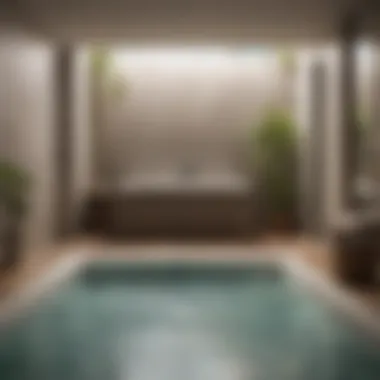

The unique feature of this enhancement is how it creates a soothing atmosphere. It offers psychological comfort by visual and physical cleanliness, making a regular cleaning routine essential for optimal enjoyment.
Assessing Your Cleaning Needs
Understanding your cleaning needs is fundamental when it comes to maintaining a jacuzzi bath tub. The effectiveness of your cleaning routine greatly relies on recognizing how often to clean and the type of build-up present. These elements define not just the longevity of the tub, but also the quality of your bathing experience.
Frequency of Cleaning
Immediate Post-Use Routine
Post-use cleaning is a crucial step many may overlook. Cleaning the tub right after use can prevent bacteria buildup and maintain overall hygiene. This routine often involves a simple rinse of the tub and jets with warm water. The key characteristic of this routine is its simplicity and quick execution. It is beneficial as it minimizes the need for extensive cleaning later, saving both time and effort.
One unique feature of this practice is its immediate preventative capability. Regular adoption prevents more severe issues from developing, ensuring that your jacuzzi remains pleasant and safe to use.
Weekly Deep Clean Suggestions
Weekly cleaning is another essential consideration. This practice involves a thorough cleaning of the entire jacuzzi, including all components and surface materials. Its primary feature is its comprehensive nature, addressing all dirt and grime that may have accumulated. It is a beneficial approach as it maintains cleanliness and assures that the tub is always in good condition.
The unique aspect of this deep clean is the required use of specialized cleaning products designed to tackle tough stains and buildup. While it requires more time and effort than post-use cleaning, the long-term benefits include maintaining both the look and functionality of the tub.
Type of Build-Up
Soap Scum
Soap scum is a common issue that many jacuzzi users face. It generally appears as a waxy, filmy residue that can accumulate on the tub’s surface. Recognizing soap scum is critical since it can harbor bacteria and lead to health concerns. The key characteristic to note is its stubbornness; without regular cleaning, it can become difficult to remove.
Fighting soap scum effectively requires using the right cleaners and often gentle scrubbing methods. Its unique feature is that it forms more readily in warm, moist environments, making jacuzzis particularly susceptible, thus reinforcing the importance of a routine cleaning regimen.
Hard Water Deposits
Hard water deposits stem from minerals found in water and tend to manifest as unsightly white spots or streaks. Addressing these deposits is essential for maintaining the aesthetic appeal of your jacuzzi. They can lead to clogging of jets and other components.
The key characteristic of these deposits is their mineral composition, which makes them difficult to avoid in many areas. Solutions often involve descaling agents or vinegar-based cleaners. Their unique feature is that while they can be great at hindering performance, they can usually be prevented with routine maintenance.
Mold and Mildew
Mold and mildew represent more serious cleaning challenges. These fungi thrive in damp environments, making jacuzzis an ideal setting for growth if not properly managed. Their appearance can indicate problematic hygiene levels and potentially pose health risks to users.
The key characteristic of mold and mildew is their rapid growth under suitable conditions, which emphasizes the need for vigilance in cleaning practices. The unique aspect of addressing these issues involves both immediate cleaning strategies and proactive methods to reduce moisture and maintain ventilation.
Regular assessment of cleaning needs is vital not only for maintaining the jacuzzi's functionality but also for ensuring an inviting and safe bathing environment.
Essential Supplies for Cleaning
Cleaning a Jacuzzi bath tub effectively requires the use of the right supplies. Having the correct products and tools can make the process more efficient and ensure that all surfaces are well-maintained. The right cleaning supplies not only help in removing dirt and grime but also protect the materials of the tub from damage. This section will highlight the necessary products and tools that homeowners should consider when setting out to clean their Jacuzzi.
Recommended Cleaning Products
Commercial Cleaners
Commercial cleaners are formulated specifically for cleaning surfaces like those found in Jacuzzi baths. These cleaners generally contain powerful ingredients designed to break down tough grime and soap scum. Their main characteristic is that they are ready-to-use, which can save time and effort. Many people favor using commercial cleaners because they often deliver quick and noticeable results.
One unique feature of commercial cleaners is the inclusion of substances that help prevent the buildup of calcium deposits and soap scum over time. This advantage can be significant for homeowners as it reduces the frequency of more extensive cleaning. However, it is important to consider the possibility of these products containing harsh chemicals that may not be suitable for all surface materials. Always follow manufacturer's instructions to avoid potential damage to the tub.
Homemade Solutions
Homemade solutions provide a more natural approach to cleaning a Jacuzzi bath tub. Often made from common household items, these cleaning solutions can be both cost-effective and safer for the environment. A key characteristic of homemade solutions is their versatility; for example, vinegar or baking soda can be mixed with water to create a suitable cleaning formula.
One distinct advantage of using homemade solutions is the ability to customize them according to personal preferences. However, it is worth noting that while these solutions can effectively tackle minor stains, they may not be as effective against heavy-duty grime compared to commercial cleaners. Additionally, it might require a bit more effort and time to get the desired results.
Cleaning Tools
Soft Brushes
Soft brushes are essential for cleaning the delicate surfaces of a Jacuzzi bath tub without causing scratches. They help remove dirt and grime gently. The main characteristic of soft brushes is their bristle composition, which is typically softer compared to regular scrub brushes. This makes them a beneficial choice for ensuring that the tub's surface remains undamaged.
A unique feature of soft brushes is their ability to reach into crevices and angles that are difficult to clean with larger tools. While they are effective, homeowners should be aware that they require some elbow grease; they may not perform as well against tougher build-ups compared to more abrasive cleaning tools.
Microfiber Cloths
Microfiber cloths have gained popularity for cleaning due to their superior ability to trap dirt and absorb moisture efficiently. They are ideal for the final polishing of a Jacuzzi bath tub, leaving behind a streak-free shine. The primary characteristic of microfiber cloths is their fiber structure, which can capture dust and grime effectively even without harsh chemicals.
One major advantage of microfiber cloths is that they are reusable and washable, making them an environmentally friendly option. However, users should ensure that these cloths are clean before each use to avoid spreading dirt around.
Squeegees
Squeegees are a useful tool for maintaining the cleanliness of the bath tub. Their primary function is to remove excess water and prevent water spots and stains on surfaces after bathing. The unique feature of squeegees is their design, which allows for effective water removal without damaging any surfaces.
Using a squeegee regularly can significantly reduce the frequency of deeper cleaning tasks, making it a popular choice among many homeowners. Nevertheless, it is important to note that a squeegee alone is not enough for a thorough clean, and it should be used in combination with other cleaning tools and products.
Step-by-Step Cleaning Process
Cleaning a jacuzzi bath tub regularly is instrumental for several reasons. First, a thorough cleaning routine helps maintain hygiene, ensuring that harmful bacteria and other pathogens do not thrive in the warm, moist environment. Second, it enhances the look and feel of the tub, making it more inviting for use. Lastly, understanding and following a step-by-step approach simplifies the entire process, helping to avoid missing any critical areas that may require attention.
Initial Preparations
Draining Water
Draining water is the first step before any cleaning process begins. It is essential to remove all water from the tub, allowing access to every surface for inspection and cleaning. This also helps prevent dilution of cleaning agents.
The key characteristic of draining water is that it gives a clear view of grime and build-up that may not be visible otherwise. Thus, it is a beneficial and necessary choice in this cleaning guide. One advantage of this method is increased efficacy in applying cleaners directly to affected areas without running water diluting their action. However, one disadvantage is the need to wait for the tub to refill after cleaning before using it again, which may be considered as inconvenient by some users.
Gathering Cleaning Supplies
Gathering cleaning supplies prepares you for an effective cleaning regimen. Having the right tools on hand is vital to avoid interruptions during the process. Common items include commercial cleaners, soft brushes, and microfiber cloths.
The key feature of gathering cleaning supplies is that it facilitates a systematic approach to cleaning, reducing the likelihood of overlooking any task. This preparation is a popular choice because it promotes more efficient use of time and enhances the overall cleaning experience. One unique aspect is that using homemade solutions can be environmentally friendly; however, one must ensure that these solutions do not damage the jacuzzi's components or surface materials.
Cleaning Jets and Components
Cleaning Jets


Cleaning jets is crucial in maintaining the tub’s functionality. Jets can accumulate grime and require focused attention. Therefore, ensuring they are clean contributes significantly to the overall health of the jacuzzi.
The characteristic that stands out when cleaning jets is targeted action. This method is vital as cleaner jets enhance water flow and pressure, improving the bathing experience. One advantage of focusing on jets is that it helps preserve their lifetime, but if not cleaned regularly, they can become clogged, rendering the jacuzzi less effective.
Scrubbing Surfaces
Scrubbing surfaces is another important step in the overall cleaning process. This involves using non-abrasive materials to avoid scratching the tub. Effectively removing dirt and build-up requires attention to detail.
A key characteristic of scrubbing surfaces is its tactile nature; this ensures that all visible grime is removed. This practice is beneficial because it restores the shine of the jacuzzi, making it pleasant to look at and use. However, this task can be labor-intensive and potentially tiresome if proper techniques are not followed.
Rinsing
Rinsing is a final critical step that reassures complete removal of cleaning agents and debris. It prevents the possibility of skin irritation caused by cleanser residues. Proper rinsing contributes to hygiene, ensuring the jacuzzi is ready for safe use.
The characteristic of rinsing is thoroughness in cleaning. It is essential to ensure no cleaning products remain on surfaces, which might degrade the materials over time. On the other hand, inadequate rinsing could lead to leftover soap or cleaner residues, defeating the purpose of the cleaning attempt.
Final Touches
Refilling Water
Refilling water is the next logical step after cleaning. It allows for testing the jacuzzi system's operational effectiveness after maintenance. This ensures that all components function as intended.
The main trait of refilling water is the necessity to assess the jacuzzi’s post-cleaning condition. It is advisable since you want to confirm that all systems are go before taking a bath. A downside to this is the waiting period involved before the tub can be used again, but this is usually acceptable given the maintenance performed.
Testing the Operation
Testing the operation is a final step that ensures the jacuzzi is fully functional. This important tactic involves running the jets and checking for any leaks or irregularities.
The key characteristic of testing the operation is confirmation of functionality after cleaning. This step is crucial to ensure everything is in order before inviting anyone to use the jacuzzi. However, if issues arise during this step, it may require further inspection or professional assistance, which could be somewhat inconvenient for the user.
Dealing with Persistent Stains
Persistent stains in a jacuzzi bath tub can detract from its visual appeal and overall hygiene. Understanding how to address these stains is essential for maintaining an inviting and functional bathing space. Stains such as soap scum, hard water marks, and even mold can develop over time. These not only affect the appearance but can also lead to long-term damage if not properly handled. Addressing such issues promptly can save time and resources in the long run.
Targeting Soap Scum
Soap scum forms when soap mixes with minerals present in the water. It can create unsightly residues on the surfaces of the tub. Tackling soap scum effectively helps restore the cleanliness of the jacuzzi and improve user satisfaction.
Specific Products for Soap Scum
Products designed specifically for soap scum removal often contain enzymes that break down the soap residue. Such products can be quite effective, especially for regular maintenance. Their key characteristic is their formulation, which focuses on cutting through greasy and waxy layers effectively.
These products are a popular choice because they work faster than conventional cleaners and can prevent buildup from developing over time. Notably, some products are non-toxic, making them a safer option for families. Their unique feature includes combinations of natural ingredients, such as citric acid, which enhance their cleaning power. However, it is worth noting that certain formulas may be harsh on delicate surfaces, and thus require cautious use.
Daily Preventive Strategies
To minimize soap scum build-up, employing daily preventive strategies is advantageous. Rinsing the surfaces after each use significantly reduces residue. This key characteristic of immediate maintenance helps to keep the bathtub cleaner for longer periods.
One effective strategy is using a squeegee to wipe down sides after use. This unique feature of a simple tool prevents water from drying on the surface and causing scum. While this practice requires consistent effort, the benefits in time saved during thorough cleanings are substantial. Neglecting this task may lead to tougher stains needing deeper cleaning solutions.
Removing Hard Water Stains
Hard water stains arise when high mineral content in water evaporates, leaving behind deposits. Addressing these stains is crucial, especially if they are frequent in specific locations, as they can form a rough texture over time.
Vinegar Solutions
Vinegar solutions are a popular choice for removing hard water stains due to their natural acid content. The effectiveness of vinegar lies in its ability to dissolve mineral deposits, making it suitable for occasional deep cleans. The key characteristic of this approach is its accessibility; vinegar is commonly found in households.
The unique feature of using vinegar is the fact that it is benign in terms of environmental impact and safe for various surfaces. However, users should be cautious, as prolonged exposure can harm certain finishes, so thorough rinsing is necessary after application.
Commercial Descalers
Commercial descalers provide a more potent alternative for dealing with hard water stains. These products are specially formulated to tackle heavy deposits and are effective in many scenarios. Their key characteristic is their strong acid content designed explicitly for mineral removal.
They are beneficial for homeowners seeking a quick solution to stubborn stains. Most commercial descalers are easy to apply, providing convenience. They often come with detailed instructions to maximize effectiveness; however, they may sometimes contain harsh chemicals that can harm sensitive surfaces if not used correctly. Understanding the specific needs of your jacuzzi bath tub will help you decide whether to use these powerful cleaners.
Addressing persistent stains promptly can not only maintain the aesthetics of your jacuzzi but also ensure its longevity by preventing areas of severe buildup.
Maintaining Water Quality
Maintaining water quality in a jacuzzi bath tub is not just about aesthetics; it is crucial for health and comfort. Clean water helps to prevent skin irritation and keeps the tub functioning properly. Over time, various factors can impact water quality, including usage frequency, environmental debris, and the overall chemical balance. Regular attention to these elements ensures that the jacuzzi remains inviting and safe to use.
Testing Water Balance
Understanding pH Levels
The pH level of the water significantly impacts overall hygiene. Ideally, the pH should be between 7.2 and 7.8. This range helps prevent skin irritation and ensures that sanitizers work effectively. Many jacuzzi owners overlook this aspect, which can lead to discomfort and increased maintenance costs. Testing kits are readily available and should be employed regularly. Monitoring this aspect helps in adjusting the water balance efficiently, contributing to a pleasant bathing experience.
Alkaline Balance
Alkalinity is another key factor in maintaining water quality. The ideal range for alkalinity is between 80 to 120 ppm. This balance stabilizes pH levels, making water easier to manage. If alkalinity is too low, pH levels can fluctuate wildly, causing challenges in sanitation and water comfort. It is crucial for owners to routinely check the alkaline balance, as correcting it can prevent more serious water quality issues.
Using Water Sanitizers
Chlorine vs. Bromine
Chlorine and bromine are the most common sanitizers used in jacuzzis. Chlorine is often preferred because it acts quickly to eliminate bacteria, but it can cause a strong smell and irritate skin and eyes. On the other hand, bromine is gentler and continues to work effectively even in higher temperatures, making it ideal for jacuzzi use. Each option has its own advantages and drawbacks. Owners need to assess their preferences and choose accordingly based on their specific watering conditions and health considerations.
Alternative Solutions
In addition to traditional sanitizers, alternative solutions are gaining popularity. Options like biguanide offer a gentle approach to sanitation, reducing skin irritation while effectively killing germs. Using natural enzymes is another route that homeowners can consider. They break down organic material without harsh chemicals, making them suitable for those who are sensitive to traditional sanitizers. While these options may come with their own set of considerations, finding the right balance can yield healthier water quality in your jacuzzi.
Preventative Measures for Build-Up
In the context of maintaining a jacuzzi bath tub, preventative measures are essential for minimizing the need for extensive cleaning or costly repairs. These strategies not only promote hygiene but also enhance the tub's longevity and overall functionality. By incorporating specific routines and being aware of material interactions, homeowners can effectively reduce the chances of build-up and subsequent issues.
Regular Maintenance Routines
After-Use Practices
After using a jacuzzi, establishing a few simple practices can significantly decrease the development of grime or build-up. Rinsing the tub out with clean water immediately after use helps eliminate soap residue and contaminants. The key characteristic of this practice is its simplicity; it requires minimal time and effort but yields considerable results. This practice is especially beneficial as it immediately reduces potential build-up from compounds in bath products and oils from the skin.
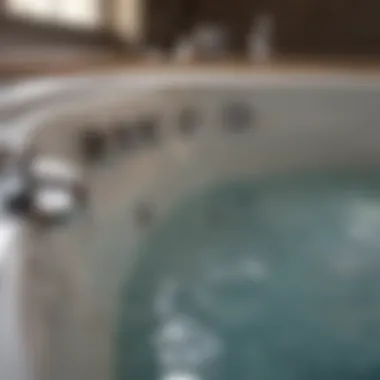
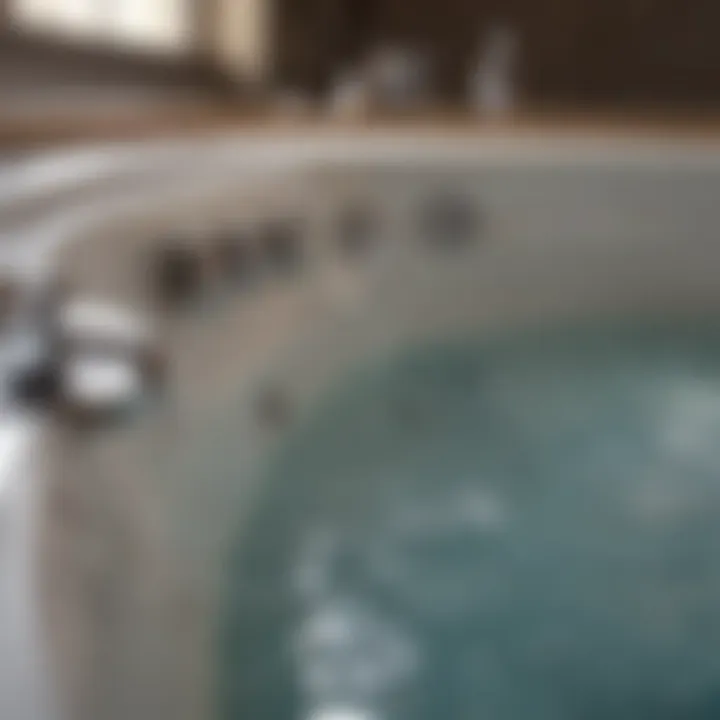
However, a disadvantage may arise if this step is skipped regularly, leading to accumulation. Regular rinsing should be emphasized as part of the maintenance routine, ensuring a clean and inviting bath area.
Monthly Deep Clean Schedule
Creating a monthly deep cleaning schedule is also crucial. This dedicated time focuses on comprehensive cleaning, targeting hard-to-reach areas and build-up that may not be addressed during regular post-use rinses. The key characteristic of this approach is its thoroughness; it allows for a meticulous attention to detail in all jacuzzi components.
Following a structured deep-cleaning approach prevents future complications, such as clogged jets or persistent stains. The unique feature of a scheduled deep clean is its organization; it can be marked on a calendar, making it easier to remember.
The main disadvantage of this method could be its time-consuming nature. However, the benefits far outweigh this inconvenience, as it leads to a healthier and better-performing jacuzzi.
Material Precautions
Choosing Non-Abrasive Products
Selecting non-abrasive cleaning products is critical for maintaining the finish of your jacuzzi. Abrasive cleaners can cause scratches and damage to the surface materials over time. Non-abrasive products are known for their gentle yet effective cleaning properties, making them a popular choice among owners.
Using these products reduces the risk of harming the surface while still providing necessary cleaning power. A significant advantage of utilizing non-abrasive materials is their ability to maintain the tub's aesthetic appeal while also preventing potential contamination from harmful chemicals.
However, one notable consideration is that non-abrasive alternatives may sometimes require more effort when dealing with tougher stains.
Caring for Surface Materials
Understanding how to care for the surface materials of the jacuzzi is another important factor. Each type of surface may have specific cleaning needs, and adhering to these can prolong the lifespan of the tub. For instance, acrylic surfaces may need different care than fiberglass or tiles. The key characteristic of this approach is its tailored method to cleaning, which recognizes the uniqueness of various materials.
This personalized care contributes to the overall maintenance goal by ensuring that the material’s integrity is preserved. A unique feature is the customization of cleaning techniques to suit specific surfaces, preventing damage caused by inappropriate cleaning methods. One disadvantage is the necessity for owners to educate themselves on their jacuzzi's particular needs, which may take time and effort.
By adopting these preventative measures for build-up, homeowners can ensure their jacuzzi remains a source of relaxation and enjoyment, free from the burdens of excessive maintenance.
Understanding Common Issues
Understanding common issues related to jacuzzi bathtubs is an essential aspect of maintaining these complex systems. Addressing these problems promptly ensures both functionality and the longevity of your jacuzzi. Homeowners and housewives need to be aware of how to identify and rectify these issues, which can diminish the bathing experience and potentially lead to costly repairs.
Clogged Jets
Symptoms of Clogging
Clogged jets are a common problem in jacuzzi bath tubs. When jets become obstructed, water flow reduces significantly, impacting the overall spa experience. Symptoms of clogging often include noticeable decrease in water pressure and uneven jet function. You may observe that some jets are completely inactive while others work intermittently.
This aspect of clogged jets matters because it directly relates to the enjoyment and efficiency of the jacuzzi. Recognizing these symptoms quickly can prevent more severe issues down the line, such as motor strain. The unique feature of tackling clogged jets is that addressing it promptly through regular checks can enhance the hydration and relaxation effects intended by the jacuzzi.
Fixing the Problem
Fixing clogged jets is a straightforward process, yet it requires attention to detail. First, shut off the power to the jacuzzi to ensure safety. Then, you can visually inspect the jets for debris, such as hair or soap residue. Use a soft brush to gently scrub the nozzles and restore functionality. Additionally, running a vinegar solution through the jets can help dissolve mineral build-up over time.
This approach is beneficial as it combines preventive and reactive measures. A unique feature of this method is that it encourages routine maintenance, which prevents future clogs. However, neglecting this step can lead to increased wear on the jacuzzi's pump and can ultimately require expensive repairs to the internal mechanisms.
Leaks and Water Damage
Identifying Leaks
Identifying leaks in a jacuzzi is critical for safeguarding the structural integrity of the entire unit. Water pooling around the tub or a sudden increase in water bills are common indicators. Check the jets, plumbing connections, and tub base for any visible signs of water escape. If your jacuzzi is losing water without any apparent cause, this warrants immediate investigation.
Recognizing leaks early can prevent major water damage and hefty repair costs. One unique feature of identifying leaks is that it prompts consumers to perform regular check-ups on their jacuzzi systems. It is an essential step to ensure that the bathtub remains in optimal condition for usage.
Best Practices for Repairs
Best practices for repairing leaks vary based on their severity. Minor leaks may be fixed using waterproof sealants or tightening of clamped connections. In contrast, extensive leaks, especially those that compromise the tub's base, may require professional intervention. Utilizing high-quality materials for repair contributes to long-term safety and functionality.
Highlighting best practices is vital. This includes regularly checking hoses, and seals, and conducting seasonal maintenance. The unique aspect of these practices is that they instill a sense of responsibility in jacuzzi owners. Adhering to these measures can avert many unwanted issues, leading to a more pleasant bathing environment.
When to Seek Professional Help
In the maintenance of a jacuzzi bath tub, there can be times when a do-it-yourself approach is not enough. Knowing when to seek professional help is crucial to ensure the longevity and proper functioning of your bath system. Some issues may appear minor but could lead to significant complications if not addressed promptly by someone with the right skills and experience. Engaging professionals can be essential for resolving specific concerns effectively.
Signs of Professional Needs
Recurring Issues
Recurring issues point to underlying problems that are not being resolved with standard cleaning or maintenance practices. You might find that despite your best efforts, the same problems keep happening. For example, water quality drops quickly even after you've treated it, or jets clog frequently after cleaning.
This persistent nature of issues often illustrates a more serious concern, such as a malfunctioning filtration system or hidden buildup in the plumbing. The key characteristic here is that they return repeatedly, which is frustrating and often a waste of time and resources. This makes it necessary to consider a professional approach.
Reasons for seeking help include access to advanced tools and techniques that a non-professional may not possess. They can also provide insights that go beyond surface cleaning, offering solutions that effectively target the root cause.
Complex Repair Needs
When faced with complex repair needs, the situation becomes one that usually surpasses basic cleaning protocols. Whether it is damaged parts, electrical malfunction, or persistent water circulation problems, these issues often require specific technical expertise.
The critical aspect of complex repairs is the level of expertise involved. Attempting to handle these issues without the right knowledge can lead to further complications and possibly significant costs down the line.
Professional technicians have extensive training. They provide not just the services, but also peace of mind knowing that the repair will be conducted to industry standards. While hiring professionals can mean higher immediate costs, it's often more economically sound in the long term, avoiding repeat expenses for fixable problems.
Choosing a Service Provider
What to Look For
In choosing a service provider for your jacuzzi cleaning or repair needs, there are several important factors to analyze. Experience and qualifications are critical here. A company with significant background in jacuzzi maintenance will likely have better insights into specific brands and systems.
Additionally, customer reviews can provide invaluable insights on their reputation. Look for providers who are responsive and engage in thorough assessments of your situation. A good provider will take time to understand your specific needs, thus personalizing their service.
Another aspect to consider is whether they offer guarantees on their work. This can assure you that the job will be done correctly the first time, reducing the need for repeat visits.
Costs to Expect
Understanding costs to expect is important when planning to hire professional services. Costs can vary widely based on the type of service required, the location, and the provider’s experience level. For routine cleaning, prices might range from moderate to somewhat higher depending on the size and condition of your jacuzzi.
For repairs, consider the parts plus labor. Complex repairs may come with higher costs due to specialized skills required. Discussing and getting an estimate upfront can help prepare you for what to expect financially.
It can also be beneficial to compare different offers from multiple service providers to estimate the most reasonable and competent service available.
Ending
Cleaning a jacuzzi bath tub is a crucial task that extends beyond mere aesthetics. The benefits of regular and systematic cleaning are multifaceted, impacting both health and wellness. When we maintain our jacuzzis effectively, we not only ensure their longevity but also create a pleasant and safe experience for all users.
Summary of Key Points
The importance of this topic cannot be overstated. Here are the essential elements discussed in this article:
- Understanding Structure: Grasping the components and mechanisms of jacuzzi systems facilitates targeted cleaning efforts.
- Health Considerations: Regular cleaning helps in preventing bacteria growth and allergies, safeguarding the wellbeing of users.
- Routine Maintenance: Establishing a consistent cleaning schedule can prevent the buildup of soap scum, mold, and other residues.
- Effective Techniques: Following detailed methods to clean jets and surfaces ensures optimal performance of the jacuzzi.
- Water Quality Management: Maintaining the proper water balance and using suitable sanitizers are essential for overall hygiene.
- Professional Assistance: Recognizing when to seek help from experts can save homeowners from costly repairs in the long run.
Ultimately, a well-maintained jacuzzi provides not only a luxurious experience but also a secure and hygienic environment. Therefore, engaging actively with the processes outlined will yield rich rewards in terms of enjoyment and safety.















